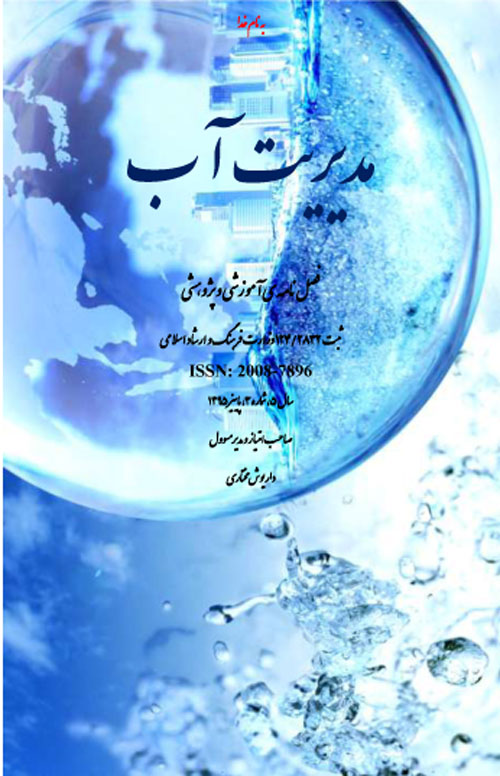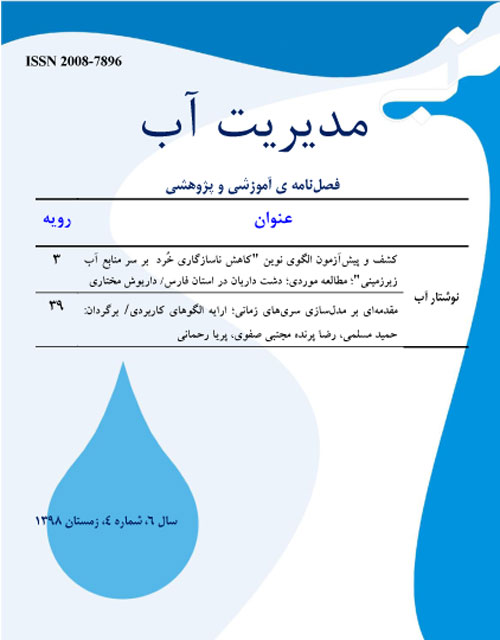فهرست مطالب

نشریه مدیریت آب
سال پنجم شماره 3 (پیاپی 14، پاییز 1397)
- تاریخ انتشار: 1397/09/07
- تعداد عناوین: 3
- گام های اجرایی نو (نرم افزاری) در مدیریت آب
-
صفحات 3-14
پیشنهاد انحلال دستگاه های اجرایی موازی به واقع یکی از اجزای کلیدی نجات آبخوان های کشور و دستیابی به حکمرانی خوب در مدیریت منابع آب و خاک کشور هست. گرچه دستگاه های اجرایی یک رکن مهم در نهاد دولت (حاکمیت) هستند، ولی کاهش ناکارآمدی در مدیریت منابع آب و خاک کشور، نه از دریچه سیاست بلکه از دریچه آسیب شناسی و ریشه یابی بی طرفانه بیشتر قابل دستیایی هست. در این درصد کلیه دستگاه 17یادداشت با کمک بررسی تاریخی، انحلال دست کم های اجرایی و پژوهشی موازی در مدیریت منابع آب و خاک کشور پیشنهاد شده است. پس از آن با هدف اصلاح چیدمان دولت برای رویارویی جدی با بحران آبخوان ها و دستیابی به "حکمرانی خوب" در بخش آب و کشاورزی، تشکیل وزارت "منابع آب و آبیاری" با کمتر از 30 درصد باقی مانده از ظرفیت های موجود اداری (ساختمان ها و نیروی انسانی) انجام می گیرد و به دنبال آن از بار مالی دولت کاسته می شود.
کلیدواژگان: وزارت منابع آب و آبیاری، حکمرانی، مدیریت، آب و خاک - نوشتار آب
-
صفحات 17-28
بیش از 2400 سال به طور مستمر در ادبیات مکتوب، نه تنها از سوی اعراب، ترک ها و ایرانی خلیج، ها، بلکه در جهان بر پهنه آبی جنوب ایران فارس و معادل های آن گفته می شده است و وجود نام های خلیج فارس، بحر فارس، بحر عجم و خلیج ایران و در سایر زبان های دنیا نیز معادل آن ها در کتاب ، های تاریخی و جغرافیایی نقشه های تاریخی و مجموعه اسناد و قراردادها میان ایران، اعراب و سایر کشورها دلیل بارز آن است. این نوشته که با روش پژوهش اسنادی انجام گرفته است، با مجموعه عهدنامه«مراجعه به کتاب و یا آرشیو وزارت خارجه » های تاریخی ایران جمهوری اسلامی ایران، مشخص شد که نام خلیج فارس حداقل در 30 عهدنامه تاریخی از هزاره اول و دوم میلادی تا نیم قرن پیش به کار رفته است. در این مقاله به این عهدنامه ها اشاره شده است.
کلیدواژگان: خلیج فارس، قرارداد، معاهدات منطقه ای و بین المللی
-
Pages 3-14
Suggestion of the ending of parallel operating executive systems is indeed one of the key components of saving aquifers in the country and achieving good governance in water and soil resources management. Although the executive agencies are an important pillar of government, the reduction of inefficiency in the management of water and soil resources of the country is more achievable, not through policy but through pathology and impartial rooting. In this note, with the help of a historical review, it is proposed to ending at least 70 percent of all parallel research and administrative apparatus in water and soil management of the country. Subsequently, with the aim of reforming the government's layout to deal with the aquifer crisis and achieve "good governance" in the water and agriculture sector, the Ministry of Water resources and Irrigation was formed with less than 30 percent of existing capacity. The administration (buildings and manpower) is followed by a reduction in the financial burden of the government.
Keywords: Ministry of Water Resources, Irrigation, Governance, Management, Water, Soil -
Pages 17-28
For more than 2,400 years, it has been repeatedly mentioned in written literature, not only by Arabs, Turks, and Iranians, but also in the world over the southern Iran, the Persian Gulf, and its equivalent and the names of the Persian Gulf, the Persian Sea, the Aajam Gulf, and the Iranian's Gulf, and in other languages of the world, are equivalent to those in historical and geographical books, historical maps and collections of documents and contracts between Iran, the Arabs and other countries. This article that prepared with documentary research method, with reference to the book "The Iranian Historical Treaties Collection" or the archive of the Ministry of Foreign Affairs of the Islamic Republic of Iran, revealed that the name of the Persian Gulf at least in 30 historical treaties of the first and second millennium. It was used half a century ago. This article refers to these treaties.
Keywords: Persian Gulf, Contract, Regional, International Treaties -
Pages 29-44
In arid and semi-arid regions, much of the urban and rural water and agricultural water is supplied by groundwater. Among these aquifers is the Tukhoor Plain, which has been in a downward trend due to the overwhelming extraction of wells over the years. In this study, the quantitative effect of Artificial Feeding Project, during the flooding period, on the groundwater level of the downstream aquifer was investigated. In order to study the impact of the dam on groundwater, two control wells and three experimental wells were used. Groundwater table fluctuations were analyzed in two statistical periods 7 years ago (19972004) and after project implementation (2004-2011). The results showed that although the rainfall data in the area before and after the project did not change significantly, the water level in all selected experimental wells increased after the project but decreased in the control wells. Has found. This indicates the positive impact of the implementation of the project on groundwater level.
Keywords: Artificial Feeding Project, Groundwater Level Changes, Hydrograph, Tukhoor Plain


